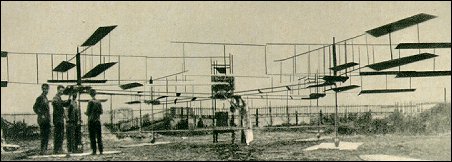
| Breguet-Richet Gyroplane No.1 1949 |  |
 |

| Breguet-Richet Gyroplane No.1 1949 |  |
 |
|
When it rose vertically from the ground with its pilot in the late summer of 1907, the Gyroplane No.1 built by Louis and Jacques Breguet in association with Professor Charles Richet had to be steadied by a man stationed at the extremity of each of the four arms supporting the rotors. It cannot, therefore, take the credit for being the first helicopter to make a free flight, even though the ground helpers contributed nothing towards the lifting power of the rotors; but it was the first machine to raise itself, with a pilot, vertically off the ground by means of a rotating-wing system of lift. Basically, the Breguet machine consisted of a rectangular central chassis of steel tubing supporting the powerplant and the pilot; from each corner of this chassis there radiated an arm, also of steel tube construction, at the extremity of which was mounted a fabric-covered 4-blade biplane rotor, making a total of 32 small lifting surfaces. One pair of diagonally opposed rotors rotated in a clockwise direction, the other pair moving anti-clockwise. The pilot, M.Volumard, was reputedly chosen at least partly because of his small stature - he weighed only 68kg. Authorities differ over the date of the Breguet machine's first flight at Douai, 24 August and 19 September 1907 being quoted with equal assurance; on this occasion the aircraft rose to about 0.60m. Take-off to some 1.50m was achieved during a test on 29 September, and similar heights were reached in several subsequent tests, but the Breguet-Richet aircraft was neither controllable nor steerable in a horizontal plane. In 1908 the Breguet-Richet collaboration produced a No.2 Gyroplane, powered by a 55hp Renault engine and having two forward-tilting 2-blade rotors with a diameter of 7.85m and, in addition, fixed wings giving an extra 50m2 of lifting surface. K.Munson "Helicopters And Other Rotorcraft Since 1907", 1968
At last, after the turn of the century, a new lightweight power plant became available. Fitted to the early automobiles and box-kite airplanes, the gasoline engine began to prove itself. In 1907, four years after the Wright brothers had flown the first controllable airplane, French designer Louis Breguet built a primitive helicopter that could lift a man into the air. It was a time of the flowering of arts and sciences in France. Although the first airplane had been flown in the United States, for the first decade the French, with Gallic passion and enthusiasm, led the world in aviation research and progress. The helicopter was a case in point, for the first machines to fly were French. The inspiration stemmed, perhaps, from the "Trium-virat Helicoidal" of fifty years before. A purist might scorn the first hops in the year 1907 as not actually being flights, since the machine was held steady by four assistants to prevent any erratic movement. But the Breguet-Richet Gyroplane No.1 did take a Monsieur Volumard — chosen for his light weight — into the air for the first time on August 24, 1907. The machine rose only to a height of about two feet, remaining in the air for one minute. Unhappily, it was not sufficiently steady or controllable for free flight, and eventually testing was discontinued in favor of building a completely new machine. The following year Breguet produced his second helicopter. It was furnished with twin 25-foot rotors, powered by a 55-horsepower Renault engine, with a set of biplane wings for good measure. On July 22, 1908, it rose vertically to the respectable height of 4.5m and flew for a short period of time, apparently under control, but the machine was completely wrecked upon landing. C.Gablehouse "Helicopters and Autogiros", 1969
It appeared more-or-less contemporarily with the airplane, when Volumand — chosen as pilot largely on account of his modest weight of 64kg — was lifted clear of the ground at Douai in France on 29 September 1907, in the elaborate Gyroplane built by Louis and Jacques Breguet under the guidance of Professor Charles Richet. The aircraft achieved a height of only 60 cm (2 ft) and was totally uncontrollable, to the extent that it had to be steadied by four assistants. But it was the first time a mechanical device had raised itself vertically from the ground with a man on board, using a rotary wing system, even if it could not be described as a free flight. The Breguet-Richet craft had a 45hp Antoinette engine and the rotors, only the rotation speed of which could be controlled, were 8m in diameter. A year later, Gyroplane No.2 appeared, with a more powerful 55hp Renault engine and two forward-tilting two-blade rotors, of slightly smaller diameter than the main lifting surfaces, which provided the thrust for forward movement. In the late summer of 1908, this aircraft was badly damaged by a heavy landing, but was rebuilt and flew again next spring. G.Apostolo "The Illustrated Encyclopedia of Helicopters", 1984
|